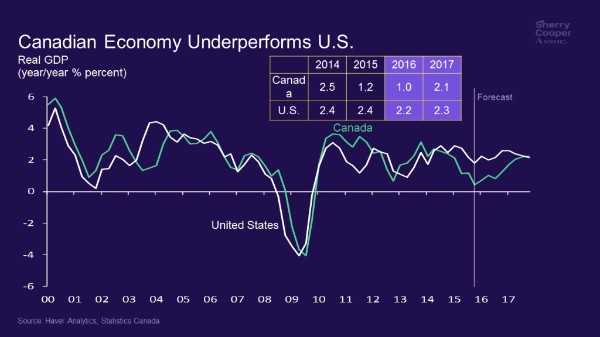Articles
Posted on March 1, 2016
Q4 Growth At 0.8% Boosts 2015 to Only 1.2%
Today’s stronger than expected fourth quarter GDP figure of 0.8% annualized growth did little to assuage concerns that the Canadian economy is growing well below potential. Many expected growth to be flat in the final quarter of last year. The growth figure released today by Statistics Canada was boosted by the biggest drop in imports in six years—the direct result of surging import prices owing to the weak loonie and the fact that Canadians are traveling less outside the country. This is hardly something to cheer about, although it does take pressure off the Bank of Canada to cut interest rates further.
Final domestic demand – GDP less net exports and inventories – actually declined in the period between October and December, reflecting big reductions in business investment, particularly in non-residential construction. Business investment declined at a 6.8% annual rate, its fourth consecutive decline. Spending for non-residential construction and machinery and equipment – key contributors to productivity growth – plunged at a whopping 13.2% annual rate, largely in the energy and mining sectors. Consumer spending growth slowed as well relative to the prior quarter.
Housing was the one bright spot in the economy, although new housing construction slowed. The growth was attributable to the continued strength in the resale market (mainly in Vancouver and Toronto), as well as housing renovations.
Export growth was very disappointing. It had been an important contributor to the growth earlier in the year. Exports of goods decreased at a 2.0% annual rate, mostly because of the decline in sales of aircraft and other transportation equipment and parts (think Bombardier).
For the year as a whole, 2015 was pretty dismal. The economy advanced only 1.2%–not nearly enough to assure adequate job creation. This was half the pace posted in 2014. Canada’s terms of trade—the price of exports relative to the price of imports—declined sharply, reflecting the sharp drop in oil prices and the surging price of imports.
Given the latest round of spending cuts and layoffs in the oil patch, first quarter growth this year is likely to be quite tepid. The recovery in manufacturing is disappointingly slow and consumer spending is dampened by rising unemployment and record-high debt levels.
Fiscal stimulus is no doubt coming to mitigate the damage of the commodity price plunge. The March 22 budget will likely increase the federal deficit to at least $30 billion, triple the Liberal Party pledge during the election campaign. The Bank of Canada meets again next Wednesday, but is unlikely to cut rates further, leaving the feds to take the lead. The Bank held off in January as well, concerned that the rise in import prices would boost inflation and hoping fiscal stimulus would come to the rescue. All eyes will be on Ottawa later this month as continued depressed growth weakens consumer and business confidence.
